In the realm of music, chord progressions serve as the stark skeleton that defines and shapes a song’s identity.
For an ambitious musician, mastering these structures is an undeniably critical aspect.
Whether you are a beginner in the musical field or an experienced maestro, understanding beautiful chord progressions can elevate your music.
It is through this understanding we bring life and emotion to a melody.
A deep comprehension of this knowledge adds substance and profound character to any piece.
Any musician, irrespective of their proficiency level, will undoubtedly benefit from gaining this resourceful toolkit.
Table of Contents
- Beautiful Chord Progressions
- I-III-IV-VI (1-3-4-6)
- ii-V-I (2-5-1)
- I-V-vi-IV (1-5-6-4)
- vi-IV-I-V (6-4-1-5)
- I-vi-ii-V (1-6-2-5)
- iii-vi-II-V (3-6-2-5)
- ii-vii°-iii-V (2-7-3-5)
- I-IV-V (1-4-5)
- I-VI-ii-V (1-6-2-5)
- iii-VI-ii-V (3-6-2-5)
- I-ii-VI-IV (1-2-6-4)
- I-IV-ii-V (1-4-2-5)
- IV-vi-I-ii (4-6-1-2)
- IV-I-V-vi (4-1-5-6)
- vi-ii-IV-I (6-2-4-1)
- IV-V-I-vi (4-5-1-6)
- vi-IV-V-I (6-4-5-1)
- The Bottom Line
Beautiful Chord Progressions
I-III-IV-VI (1-3-4-6)
A harmonious balance providing a unique soothing melodic landscape.
The I-III-IV-VI chord progression, also known as 1-3-4-6, offers a heartfelt and slightly melancholic mood that adds rich emotional undertones to any composition. It carries a perfect balance of positive and sorrowful nuance, making it a favorite among musicians for its potential in creating deeply resonant and beautiful music.
- Difficulty: Intermediate
- Example: G – B – C – E (Key of G major)
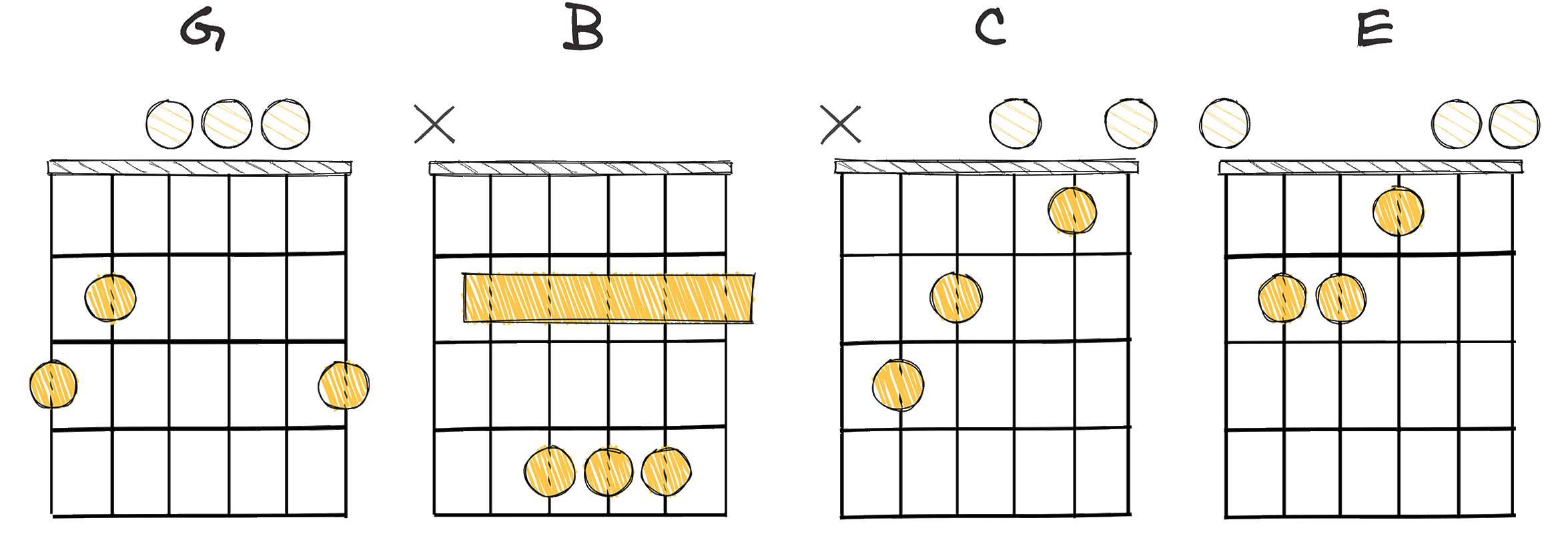
If you’re on a quest for beautiful chord progressions, then you’d be remiss not to explore progression number I-III-IV-VI (1-3-4-6).
As a progression, it is fairly easy to play and creates a melodic and harmonious sound that’s adored by listeners across various genres.
Stemming deep in music history, this progression’s roots can be traced back to classical compositions ranging from Beethoven to Mozart.
It’s a testament to the timelessness of the I-III-IV-VI.
Fast forward to more recent times and this progression has been embraced by modern music.
Its application extends from country ballads to pop anthems and transcendental rock songs.
In the key of G Major, this progression is easy to play and offers a harmonious sound that beautifully supports the song’s melody.
The incredible versatility of I-III-IV-VI gives musicians countless opportunities to experiment within their compositions.
Other than “Every Breath You Take”, there are scores of songs across many genres that utilize this progression, making I-III-IV-VI an essential element in the toolkit of a musician.
From classical era masterpieces to modern pop anthems, I-III-IV-VI has proven an effective tool for musicians aiming to create memorable melodies and emotional tunes.
Knowing how to utilize and apply this progression could significantly enhance one’s song-writing prowess, as it’s a proven tool that strikes a chord with music listeners universally.
Understanding I-III-IV-VI and its various applications can potentially unlock new avenues of creativity within song composition.
ii-V-I (2-5-1)
The cornerstone of jazz, defining harmony within perfect resolution.
The II-V-I progression is one of the most commonly used chord progressions in jazz music, known for its smooth transition and melodious resolution. This progression creates a harmonious flow, making the music sound interconnected, reflecting a beautiful sense of completion.
- Difficulty: Intermediate
- Example: Em – A – D (Key of D major)
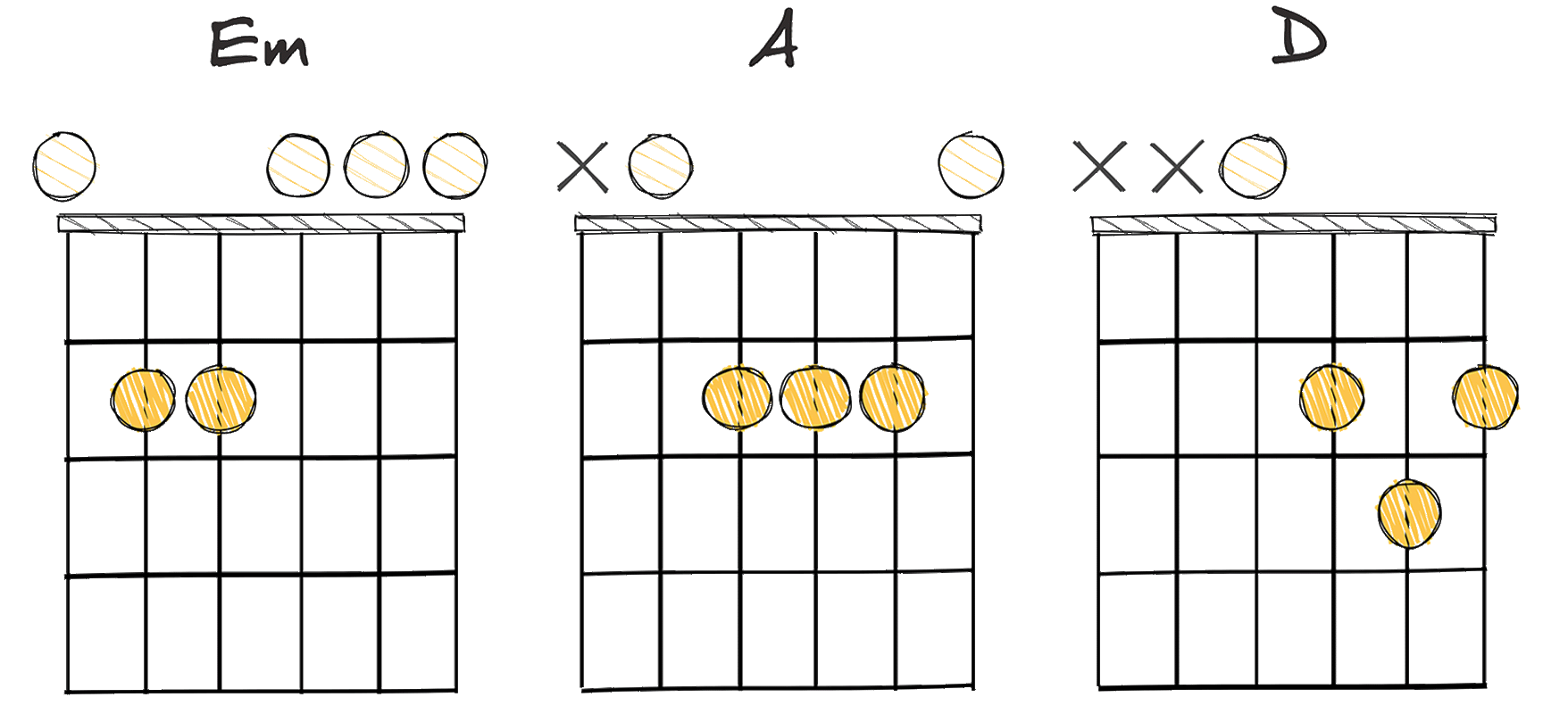
The ii-V-I (2-5-1) chord progression is a vital part of many musical genres, including jazz, blues, rock, and pop.
It is a popular sequence that any musician dedicated to mastering their craft must be familiar with.
Delving deeply into its history, the ii-V-I progression has been a staple element in Western music for centuries.
It made a significant impact in Baroque music, where it aided in bringing forth resolution to harmonic tension, thereby creating a rewarding listening experience.
The ii-V-I progression is well-loved for its rhythmic and harmonic attributes.
The beauty of its sound lies in its perfect balance.
It employs a great sense of tension and release, which is integral to evoking the various emotional responses in listeners.
The ii-V-I progression is considered to be at a intermediate level of difficulty to play.
This makes it moderately accessible for budding musicians.
Learning to master this progression can directly impact a musician’s ability to adapt and play various genres of music quickly.
This is because the ii-V-I progression is incredibly common and forms the backbone of many compositions.
It’s important to note that the actual chords in this progression may change depending on the key in which you’re playing.
In the key of D major, for instance, the ii-V-I progression would translate to the chords Em – A – D.
Once you get comfortable with this progression, you’ll notice its prevalence in many other songs.
It forms the backbone of numerous memorable melodies, signifying its prominence in the world of music.
Therefore, mastering the ii-V-I progression serves as a gateway to understanding more complex harmonies and rhythms.
Overall, the ii-V-I progression is an exquisite example of the kind of beautiful chord progressions that musicians should know and use to create compelling and harmonious music.
As a musician, understanding, memorizing, and using this chord progression in your works can enrich your musical palette and aid in your journey of creating captivating sonic experiences.
The ii-V-I progression is a beautiful musical phenomenon that is not only pleasing to the ear but also magnificently effective in conveying various emotions and stories through music.
I-V-vi-IV (1-5-6-4)
Common yet captivating progression, backbone of many iconic songs.
The I-V-vi-IV chord progression is commonly used in both pop and classical music due to its versatile and emotive qualities. Known for its catchy yet satisfying sequence, it provides a strong foundation for many memorable hooks and melodies, evoking a wide range of moods.
- Difficulty: Easy
- Example: C – G – Am – F (Key of C major)
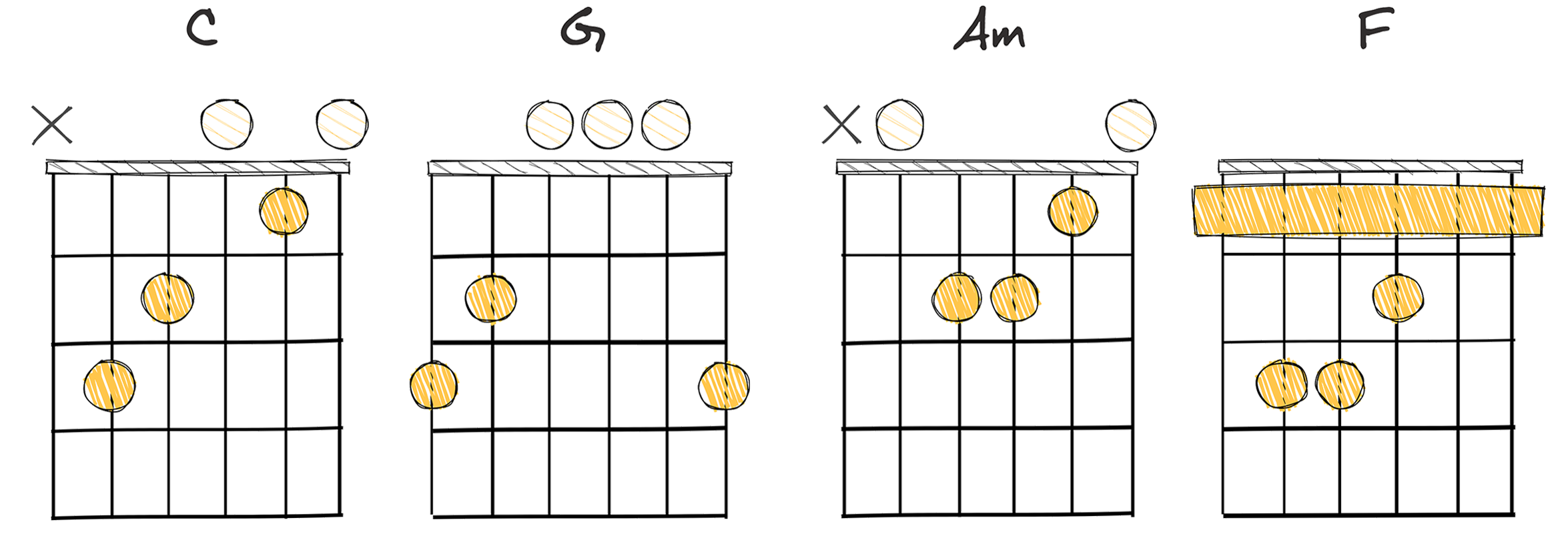
The I-V-vi-IV chord progression is one of the most frequently used set of chords in popular music.
One reason for its popularity is its simplicity and versatility, allowing musicians to evoke a variety of moods and impressions using only four chords.
Developed over centuries of western music, the I-V-vi-IV chord progression is inherently melodious and easy to play which contributes to its adaptability in a multitude of songs.
Given the progression revolves around the major key, it creates a sense of optimism and fulfilment, making it an ideal choice for pop and rock tracks.
The transition from the V chord to the vi chord is particularly impactful.
This change between a major chord to a minor creates a compelling emotional shift, inducing a feeling of pensiveness in an otherwise upbeat progression.
From a technical perspective, the I-V-vi-IV can be demonstrated in the key of C major: C – G – Am – F.
This effectively illustrates its simplicity while providing a recognisable and easily playable chord sequence.
Understanding this, it’s no surprise that such a simple yet effective progression is prevalent in various genres of music.
Its easy playability and remarkable emotional range make it a top choice for composers.
Notable examples of songs featuring the I-V-vi-IV progression abound, spanning myriad genres and periods.
The enduring prevalence of the I-V-vi-IV chord progression in modern music is a testament to its timeless appeal.
Its simplicity and versatility have made it a staple in Western popular music, with its influence echoing through countless songs across the decades.
Although the I-V-vi-IV progression may sound familiar to listeners, its varying usage by artists ensures that it never grows stale or predictable.
From the hands of an accomplished musician, the simple chords of the I-V-vi-IV chord progression can be transformed into a masterpiece of musical expression.
vi-IV-I-V (6-4-1-5)
This progression offers an achingly beautiful emotional resolution.
The vi-IV-I-V chord progression is a popular sequence used frequently in various genres of music, known for its melancholic yet melodious nature. It starts on the sixth note of the diatonic scale, moves down to the fourth, down to the first, and finally jumps to the fifth, resulting in a harmonious blend of chords that evokes a sense of resolution and closure.
- Difficulty: Easy
- Example: Am – F – C – G (Key of C major)
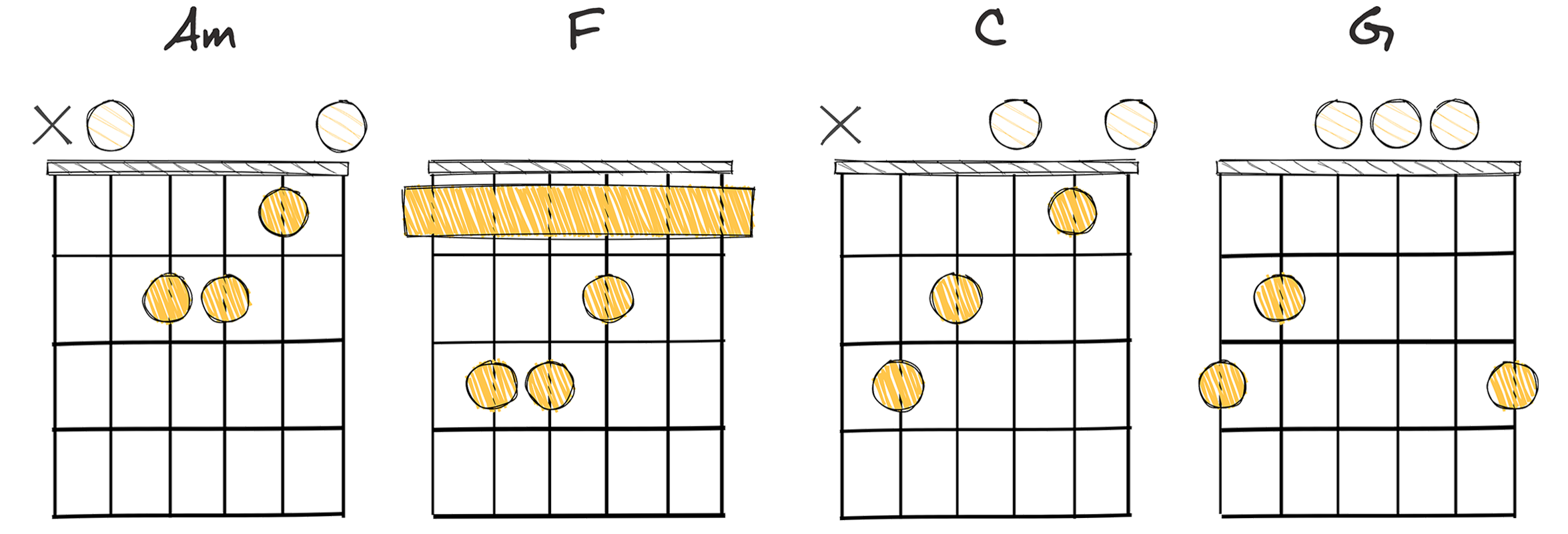
The vi-IV-I-V chord progression is one of the most versatile and beautiful progressions every musician should know.
It is quite popular and holds an essential place in the annals of music history.
As for its origin, the roots of this progression can be traced back to classical music, and it subsequently infiltrated into popular music genres.
With such a rich legacy, the vi-IV-I-V progression has been widely utilized by composers and songwriters spanning several centuries and transcending numerous musical genres.
It’s a simple yet beautifully elegant progression that offers a sense of resolution and emotional depth.
This progression is easy to play and offers a sort of musical satisfaction to the listeners.
The resolution from I to V in particular, creates a strong sense of finality and brings the musical phrase to a meaningful close.
Just by altering the order of chords slightly, the mood and feel of a piece of music can be significantly transformed.
The vi-IV-I-V progression, given its simplicity and versatility, is a good starting point for anyone interested in creating their own music.
It’s a chord progression that is quite friendly for beginners while continuing to inspire even the most seasoned musicians.
This progression, in the Key of C major, would be represented by the chords Am – F – C – G.
These keys’ simplicity and the progression’s flexibility make it an excellent choice for both seasoned musicians and beginners alike.
Most importantly, musicians should strive to understand the underlying concept and then experiment with this progression on their own.
The progression’s inherent beauty and its ubiquitous presence in so many beloved songs make it a must-know chord progression for any musician.
I-vi-ii-V (1-6-2-5)
A harmonic sequence that is quintessential in countless jazz standards.
The I-vi-ii-V chord progression, also known as 1-6-2-5, is a popular sequence in many genres of music due to its melodic and harmonic appeal. It is known for its smooth transitions and predictable resolutions, making it an ideal choice for songwriters and composers to add depth and interest to their compositions.
- Difficulty: Easy
- Example: C – Am – Dm – G (Key of C major)
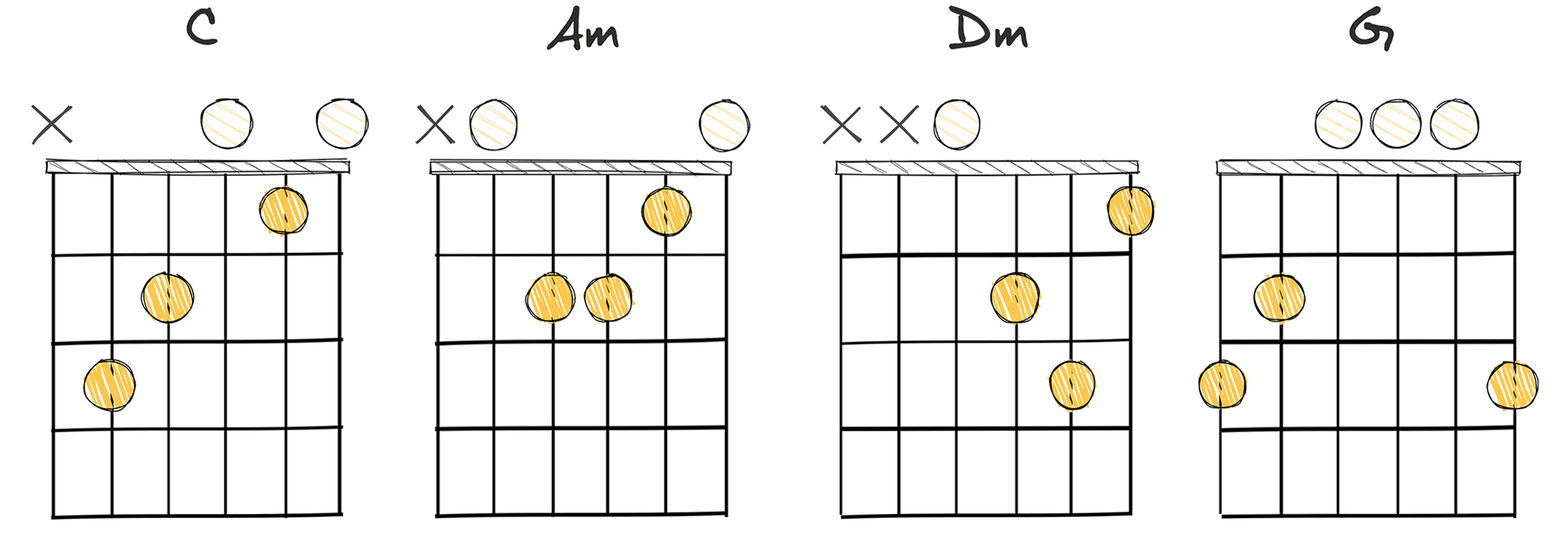
The I-vi-ii-V (1-6-2-5) chord progression is a beautifully melodic sequence that has been treasured by musicians across multiple genres and cultures throughout history.
Reflecting upon its roots, the I-vi-ii-V progression traces its origins back to classical music, displaying a delicate balance of harmonic tension and resolution that captivates the listener’s ear.
Respected for its elegant simplicity, this type of progression is often considered easy to play, making it widely accessible to musicians of all skill levels.
This foundational chord progression serves to showcase the potency and profundity of simple yet effective harmonic structures.
Moreover, the resonance and dynamic shifts facilitated by the I-vi-ii-V progression create a nuanced musical framework, presenting opportunities for expressive interpretation and improvisation.
Aspiring songwriters and composers often learn this progression early in their musical education, thanks to its widespread usage and accessible structure.
The I-vi-ii-V progression’s inherent melodic and harmonic possibilities lend themselves to a variety of musical contexts, from pop ballads and jazz standards to classical compositions and beyond.
It also provides a solid starting point for more complex harmonic explorations, making I-vi-ii-V a favorite among musicians looking to deepen their understanding of theory and composition.
To the untrained ear, the progression might sound deceptively simple, but beneath its straightforward surface lies a vast universe of subtle beauty and musical profundity.
That being said, regardless of the complexity of the composition or the performer’s level of expertise, the power and emotive capability of the I-vi-ii-V progression is undeniable.
iii-vi-II-V (3-6-2-5)
A classic, smooth transition yielding a rich harmonic soundscape.
The iii-vi-II-V chord progression, also known as the 3-6-2-5, is a beautiful and classic chord succession often found in various genres of music, especially jazz. As it smoothly transitions chord to chord, it creates a comforting sequence that is often used as a turnaround, leading back to the beginning of the chord progression.
- Difficulty: Intermediate
- Example: Em – Am – D – G (Key of C ajor)
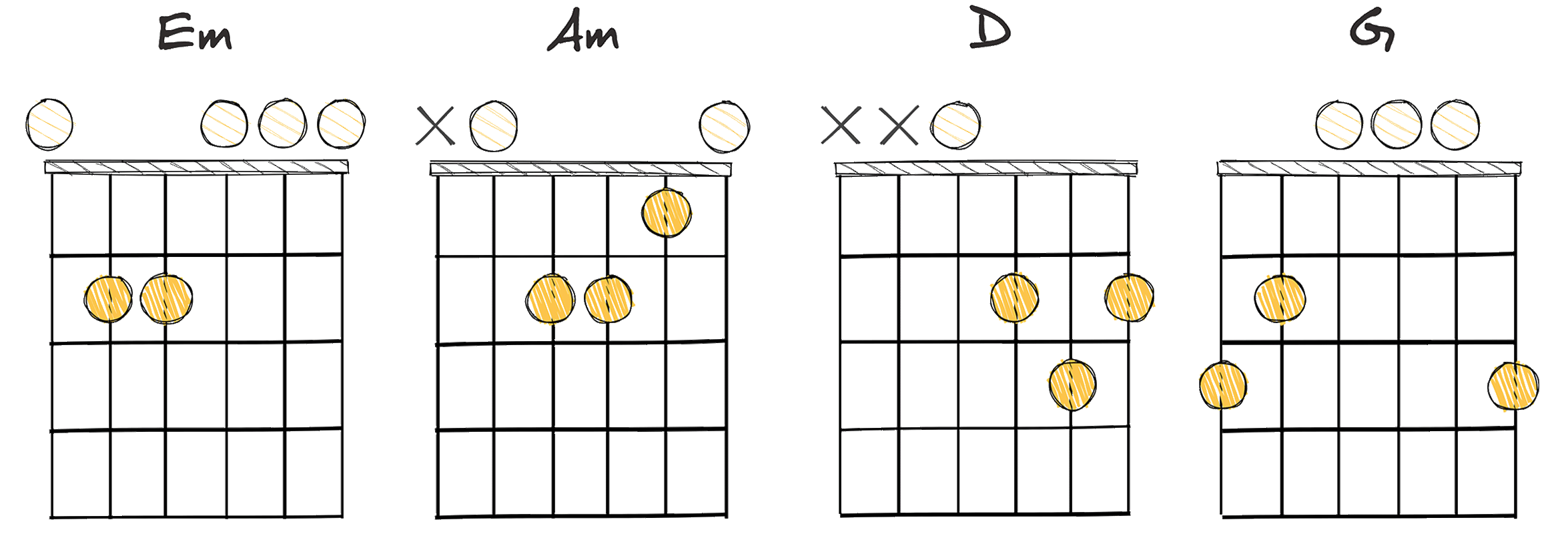
The sensational magic of music is beautifully captured in chord progressions.
The iii-vi-II-V (3-6-2-5) progression, to be exact, is one such enchanting musical pattern that tugs at your heartstrings.
This quintessential progression holds an alluring appeal that many musicians love delving into.
Part of the charm of this progression lies in its intermediate complexity level, making it an interesting challenge for budding musicians.
Its further allurement stems from its pleasantly unexpected yet musically consonant sequence.
It veers off the beaten path of traditional I-IV-V (1-4-5) and II-V-I (2-5-1) progressions, opening up new musical frontiers for both performers and listeners.
It’s worth noting that on the example we have, the D major chord (II) is not diatonically a part of C major; typically, you’d have D minor (ii) in C major.
But the D major chord can be seen as a borrowed chord or a secondary dominant that targets the G chord that follows it.
The history of this progression is a riveting journey through the annals of music.
It dates back to the golden age of jazz, witnessing an evolution crowning it as a go-to progression amongst many musicians.
The iii-vi-II-V (3-6-2-5) progression became a mainstay in genres like jazz, pop, and soul, often used to create tension that resolves into melodious satisfaction.
This progression’s pivotal role in these genres has largely shaped their distinctive sound.
It’s mastery, therefore, is super beneficial for those aspiring to excel in these musical styles.
The prominence of these chords in the song illustrates the progression’s versatility and adaptability, allowing it to transcend multiple genres and patterns.
Indeed, the iii-vi-II-V progression represents an alluring musical treasure trove for musicians to explore and extract plenty of brilliant musical ideas.
Drilling this progression into your musical arsenal will undoubtedly elevate your music.
ii-vii°-iii-V (2-7-3-5)
A harmony-rich progression offering an irresistible sense of musical movement.
This ii-vii°-iii-V chord progression is a beautiful and melodious sequence that offers a unique contrast and balance, perfect for sparking creativity in any musician. With its harmonious movement from one chord to another, it brings a remarkable depth and sentiment to the music, making it an essential progression for any musician to master.
- Difficulty: Intermediate
- Example: Dm – Bdim – Em – G (Key of C major)
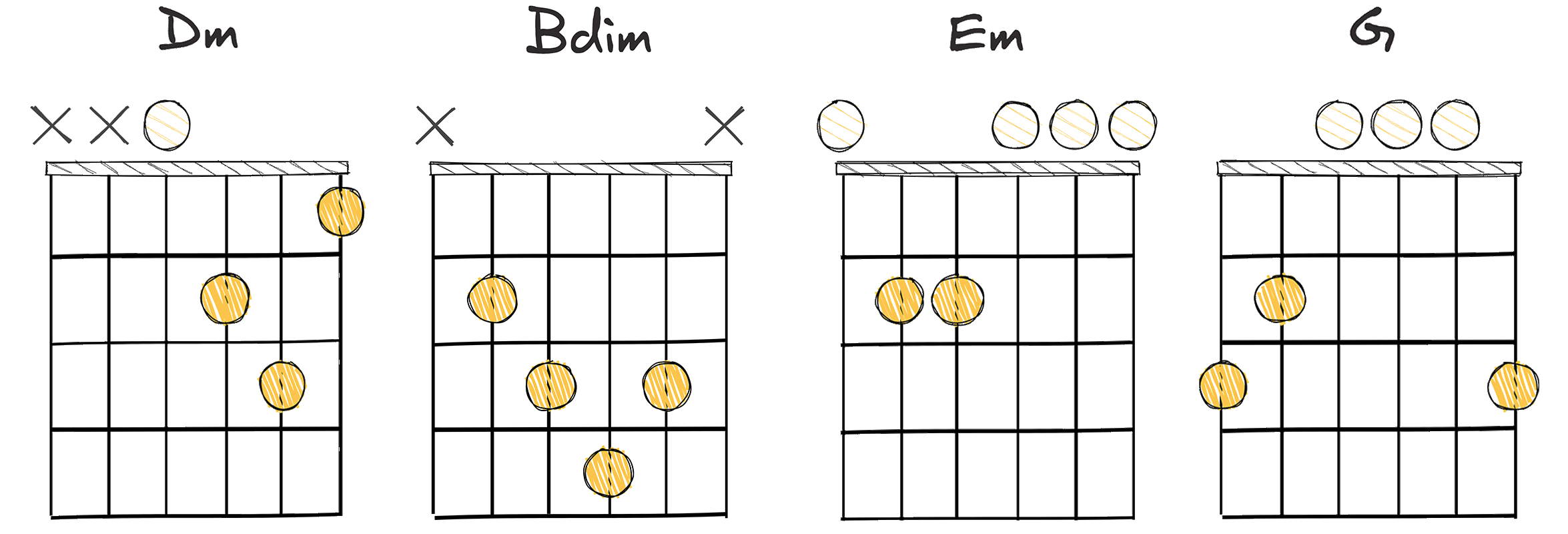
Chord progressions, also known as chord sequences, form the harmonic basis of a piece of music.
They are one of the key aspects that give a song its unique identity, and they can have a profound impact on how the music is perceived.
Theii-vii°-iii-V (2-7-3-5) chord progression has a rich history.
It doesn’t show up as commonly as theii-vii°-iii-V (2-5-1) progression, but it’s frequently used in a variety of genres, especially those with a jazz influence.
The 2-7-3-5 progression tends to have a more complex sound compared to other progressions, making it appealing to musicians who want to create more nuanced, sophisticated melodies.
This chord progression, ii-vii°-iii-V, often contributes to intricate and intriguing harmonies due to the tension and resolution patterns it produces.
When you look deeply into the minute harmonic details within this progression, you’ll find that it practically forces human ears to pay more attention.
It offers an unexpected musical journey, taking listeners through unpredictable twists and turns before resolving to a comfortable conclusion.
Chord progressions like the ii-vii°-iii-V often create a more complex and sophisticated sound, and as such, they are not generally considered beginner-friendly.
As such, it would be safe to categorize this particular progression as being Intermediate in nature.
It requires some knowledge and understanding of music theory, along with practice, to be comfortably executed.
The progression can sometimes be challenging to implement, but it’s the unique harmonic journey it offers that makes it absolutely worth exploring, especially for musicians looking to break away from the more commonly used chord progressions.
Further, the ii-vii°-iii-V progression can almost be seen as a musical secret weapon, offering the twofold advantage of being both interesting to the ear and unexpected to the listener.
Musicians who can understand and incorporate this progression into their work will find themselves creating melodies that leave a lasting impression.
The ii-vii°-iii-V progression really is a beautiful example of how harmonic tension and resolution can make a significant difference in a piece of music.
Its rich, sophisticated sound can add depth to your compositions and captivate your listeners.
I-IV-V (1-4-5)
The quintessential backbone of rock and blues, simple yet profound.
The I-IV-V is a classic progression often used in various genres of music, providing a simple yet captivating harmonic structure. The progression gives a perfect combination of tension and release due to the movement from the home chord (I) to the subdominant (IV), then to the dominant (V), creating a melodious tune that is attractive to the ear.
- Difficulty: Easy
- Example: G – C – D (Key of G major)
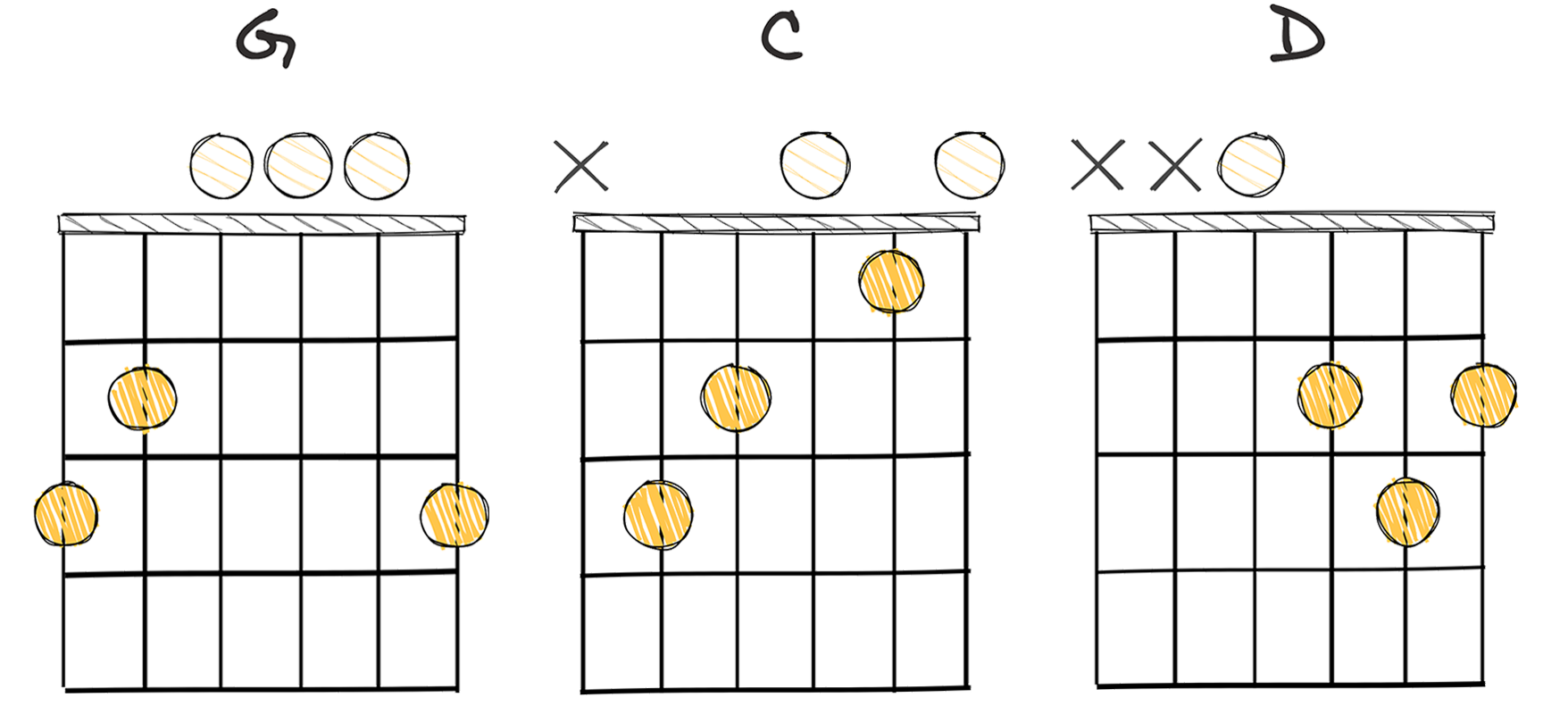
The chord progression I-IV-V (1-4-5), famously known as the “three-chord trick”, is one of the simplest and most ubiquitous progressions in music.
This universal formula has been a cornerstone of popular music for decades and continues to enrich songs, proving its timeless quality.
This progression is frequently utilized due to its ease-of-use and adaptable nature which makes it accessible to musicians of varying skill levels.
The I-IV-V progression’s roots can be traced back to blues music where it first gained prominence.
Borrowing from the rhythm of the twelve-bar blues, it provided a great harmonic foundation for blues musicians to work upon.
Musicians found this progression to be a perfect fit because of the transitions, which created tension and resolution that naturally appealed to listeners.
The progression’s simplicity allows it to blend seamlessly into the background, allowing the focus to stay on the melody and lyrics of the song.
Through these years, various musicians across genres and eras have utilized and continue to employ the I-IV-V progression to create timeless and genre-defining hits.
This powerful, yet simple progression, is an instrumental tool for any aspiring musician or songwriter to familiarize themselves with.
Ultimately, the enduring value and versatility demonstrated by the I-IV-V progression make it a vital knowledge piece of musical theory for any musician on their creative journey.
I-VI-ii-V (1-6-2-5)
A staple progression that delivers smooth transitions and resolve.
The I-VI-ii-V chord progression, also known as the 1-6-2-5, is a popular sequence used in various genres of music that creates a smooth, melodic flow. This progression, with its resolution back to the tonic or ‘home’ chord, gives a harmonious sense of ‘return’ that is pleasing to the ear, making it a staple for many musicians.
- Difficulty: Intermediate
- Example: C – A – Dm – G (Key of C major)
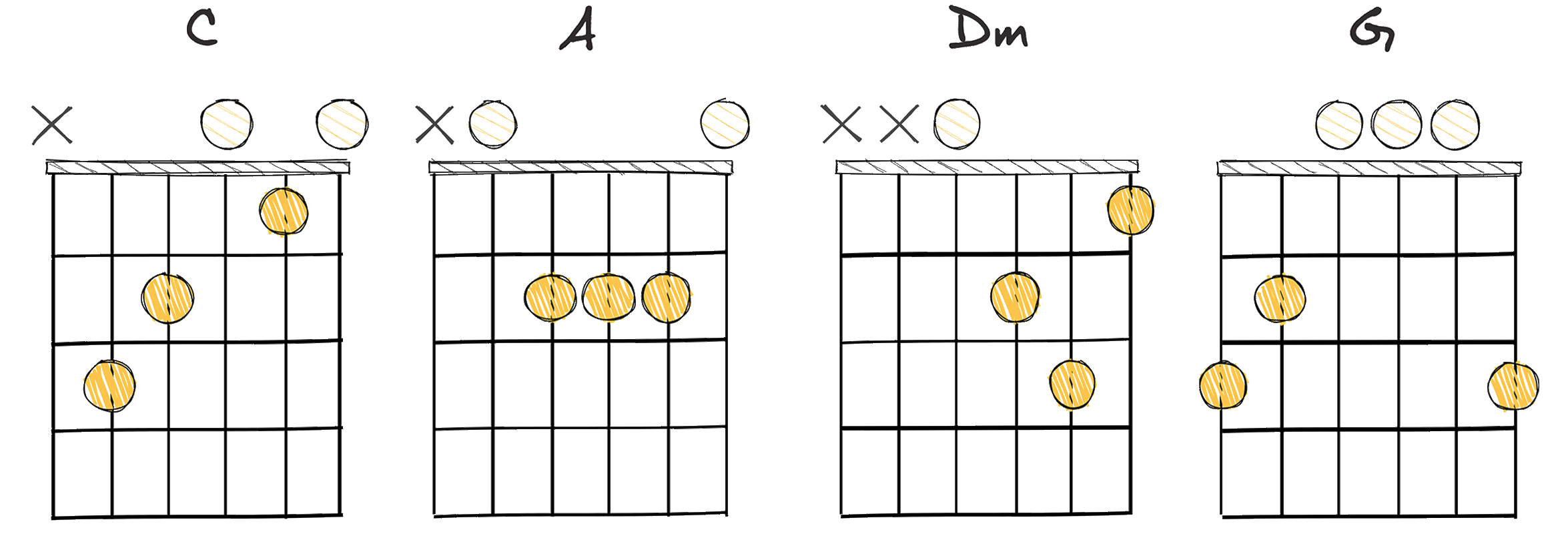
The I-VI-ii-V (1-6-2-5) chord progression, also known as the ‘turnaround’ progression, holds a central position in the latticework of many unforgettable music compositions.
Typically found in the intermediate difficulty levels, this chord progression is a favourite for many musicians owing to its ability to loop back to the tonic or ‘home’ chord seamlessly, thus, enhancing a composition’s cyclical nature.
By studying the unique history of the I-VI-ii-V chord progression, we can observe its prominence in Jazz music, notably in pieces composed in the mid to late 20th century.
In Jazz, this progression punctuates the ends of sections and songs, asserting an unmistakable sense of finality and bringing the melody back to its starting point.
This perennial Jazz standard is distinguishable by its sinuously slow melody and the clever use of the I-VI-II-V progression highlights the underlying tension and resolution within the melody.
Weaving through the chords of C – A – Dm – G (assuming the Key of C major), the song manages to create a harmonious balance between the melodious lines and the chord movements, thereby underlining the song’s evocative mood.
Another interesting observation about the I-VI-ii-V progression lies in its innate flexibility.
While it holds its own as a self-contained progression, musicians often nest it within other harmonic structures, thus enriching their compositional palette.
Similarly, the same progression can take on different emotional shades depending on the genre it’s incorporated into.
In jazz and blues, it adds a subtle sense of restlessness, while in pop and country music, it brings out a strong sense of resolve and closure.
Despite its simple structure, the I-VI-ii-V chord progression brings interlinked complexity and freshness to a piece.
This demonstrates the unique power of chord progressions, as they can inject depth, convey mood, and shape the sonic story that a composer wishes to tell.
Although the I-VI-ii-V chord progression is typically seen in intermediate to advanced level compositions due to its inherent predictability, the mellifluous pathway it creates between the root, instrumentalist and listener renders it a favourite among many.
Music remains a fascinating, deeply personal exploration of art and identity.
Just as an artist experiments with different hues and brush strokes before creating a masterpiece, the selection of chord progressions is fundamental to shaping a piece’s overall structure, harmony and emotional context.
No matter what genre a musician composes in or how advanced they are in their musical journey, the I-VI-ii-V chord progression will undoubtedly remain a beautiful, versatile backbone for countless compositions to come.
iii-VI-ii-V (3-6-2-5)
A staple progression in jazz, oozing sophistication and nostalgic charm.
The iii-VI-ii-V chord progression, also known as 3-6-2-5, is a popular sequence in music that creates a sense of movement and resolution, often leading back to the tonic or root chord. Noted for its smooth, harmonious transitions, it is frequently utilized in a variety of genres, particularly jazz and pop, yielding a timeless, melodious sound.
- Difficulty: Moderate
- Example: Em – A – Dm – G (Key of C major)
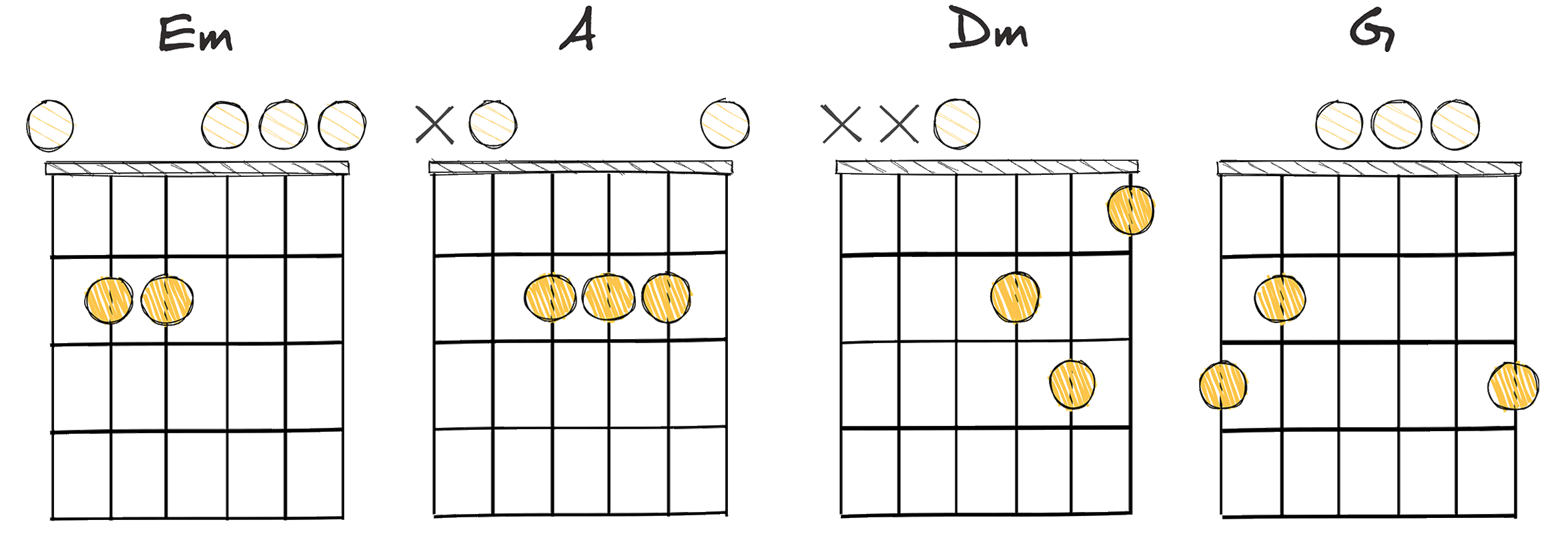
The iii-VI-ii-V (3-6-2-5) chord progression is one of the beautiful sequences that every musician should familiarize themselves with.
This progression has a fascinating, smooth flowing melodic development that can make any listener’s ear appreciate its pleasant sound.
Looking at its history, the iii-VI-ii-V (3-6-2-5) chord progression has been widely used in various genres; jazz, pop, rock and even classical music.
Known for creating a rich emotional layer within music, this progression exemplifies the aesthetics of tonal harmony and aids in establishing tonal center by moving from the mediant to the submediant, then to the supertonic and finally to the dominant chord.
Given its historical significance and wide appreciation, I would categorize the difficulty level of playing this chord progression as moderate.
It might be somewhat challenging for beginners due to the step-wise chord movement, but it can be mastered to perfection with determined practice.
In the key of C major, the iii-VI-ii-V (3-6-2-5) chord progression would be played as Em – A – Dm – G.
Though the specific voicings or inversion of these chords can vary depending on stylistic intent, these chords remain the foundation upon which the progression is built.
If we’re seeking more modern examples of songs employing the iii-VI-ii-V progression, there are numerous pop songs that make use of it.
After all, such a universally beloved progression lends itself perfectly to pop music’s emphasis on catchy, satisfying melody and harmony.
As we venture through the rich, emotive nature of the iii-VI-ii-V progression, we’re once again reminded of the grand power of musical harmony.
This progression, with its inherent transitional progression, truly exemplifies the artistry involved in creating intriguing, enriching musical projects.
At the end of the day, the beauty of iii-VI-ii-V (3-6-2-5) chord progression lies in its musicality and ability to connect with the human spirit.
It’s all about creating that musical journey that showcases not just the talent of the musician but the heart and soul behind the music.
I-ii-VI-IV (1-2-6-4)
A melodic journey, the I-ii-VI-IV progression anchors countless hit songs.
The I-ii-VI-IV progression is a stunningly beautiful and melodious sequence often found in various genres, particularly in pop and rock music. It provides a soothing and captivating harmony, serving as a perfect foundation for numerous popular songs, and is a classic progression that all musicians can benefit from mastering.
- Difficulty: Intermediate
- Example: C – Dm – A – F (Key of C major)
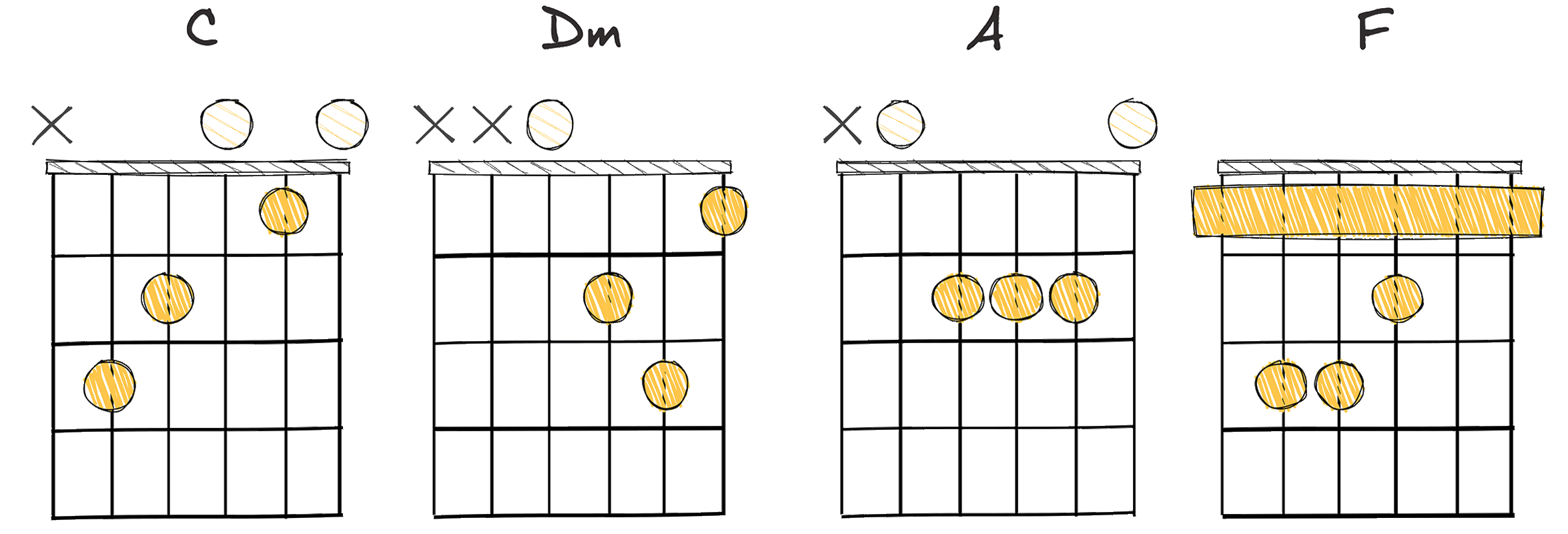
Musical chord progressions are the foundation of any excellent song, and the I-ii-VI-IV (1-2-6-4) progression is an exceptionally beautiful one.
This progression holds a special place in the world of pop music for its magical ability to make songs catchy and memorable.
It is interesting to note that the I-ii-VI-IV progression has been widely used in many popular songs all across the world.
In the realm of pop, rock, and even the country music genre.
The I-ii-VI-IV progression is inherently captivating and melodic, based largely on its balance of the perfect fourth and fifth intervals.
This balance, in conjunction with its sequential yet unpredictable nature, gives the I-ii-VI-IV progression an element of surprise that endears it not only to songwriters, but also to listeners.
One could say that the beauty of the I-ii-VI-IV chord progression is in its flexibility and adaptability, able to support a diverse range of moods and emotional tones.
For instance, a song written in the key of C major with this progression would move through the chords – C – Dm – A – F.
This specific chord progression conveys a sense of melancholy and longing.
Speaking of which, one notable song that masterfully utilised this progression is “Let It Be” by The Beatles.
Nevertheless, it’s important to remember that while this progression is enchanting and engaging, it is considered Intermediate to play.
This is mainly due to the fact that the chords need to be changed rapidly in the middle of the progression, which may pose a bit of a challenge to beginner musicians.
However, with diligent practice and familiarity with the chords, mastering the I-II-VI-IV progression can significantly enhance one’s musical repertoire.
Learning and understanding this progression provides valuable insight into the art of songwriting and the magic of music creation.
I-IV-ii-V (1-4-2-5)
A delightful harmony creating joyful upliftment in musical composition.
The I-IV-ii-V chord progression is an elegant and timeless sequence, often used in a variety of music genres for its smooth transition and harmonious sound. Regarded as a cornerstone in both classic and modern music, this progression offers a balance of tension and resolution, resulting in a melodically satisfying musical phrase.
- Difficulty: Intermediate
- Example: G – C – Am – D (Key of G Major)
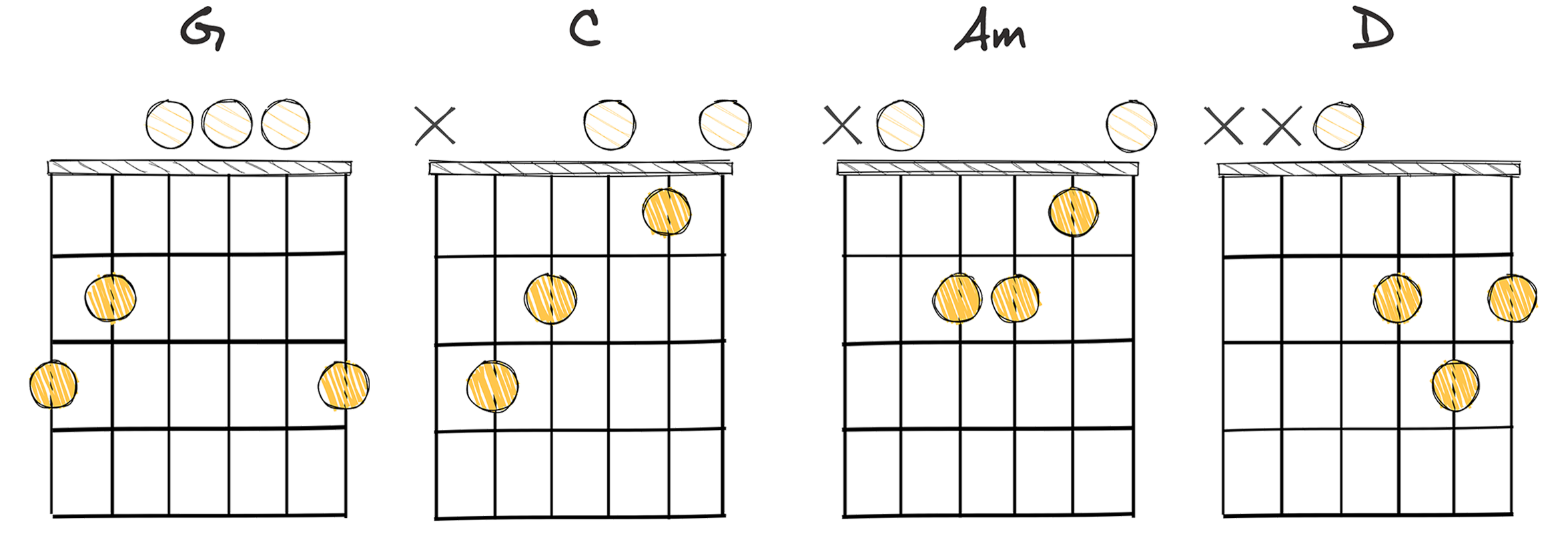
When one delves into the world of chord progressions, there is a myriad of exciting and evocative options to explore.
The I-IV-ii-V (1-4-2-5) chord progression, also known as the “circle of fifths” progression, is one such captivating combination.
Historically, this progression has been profoundly influential in shaping the landscape of a variety of music styles, from classical to jazz and pop.
The specific chords used in this song, G – C – Am – D (Key of G Major), illustrate how versatile and adaptable the I-IV-ii-V progressional structure is, as it can be seamlessly incorporated into different musical compositions and genres.
That being said, it is important to note that the I-IV-ii-V progression is of an intermediate complexity level.
Though it’s not typically recommended for beginners, this progression offers an invigorating challenge for musicians with some experience under their belt.
Working your way around the chords requires a certain level of understanding regarding musical theory, knowledge of piano or guitar fingerings, and the ability to easily transition from one chord to another.
This chord progression is widely appreciated for its unmistakable character that can inject a dose of inspiration and fluidity into a musical piece.
The I-IV-ii-V progression is noted for its distinct tonal effect, as it modulates around the cycle of fifths to create a sense of dynamic movement and resolution.
This progression’s circle-of-fifths sequence grants the musician a great degree of creative flexibility, making it possible to compose sophisticated and engaging melodies.
It’s worth mentioning that mastering the I-IV-ii-V progression is a significant benchmark for emerging musicians, as it equips them with a powerful tool for their future compositions.
This chord progression’s value lies in its capacity to present a rich tapestry of emotional expression, elicit a deep-seated resonance with listeners, and ultimately, orchestrate a compelling narrative within the music.
IV-vi-I-ii (4-6-1-2)
A harmonious transition evoking emotions through unconventional resolution.
The IV-vi-I-ii chord progression brings an emotionally expressive, sentimental and subtle melancholic tone to musical compositions. Its transition creates tension and resolution that gives the music a sense of motion, making it perfect for introducing dynamics in storytelling through music.
- Difficulty: Intermediate
- Example: G – Bm – D – Em (Key of D major)
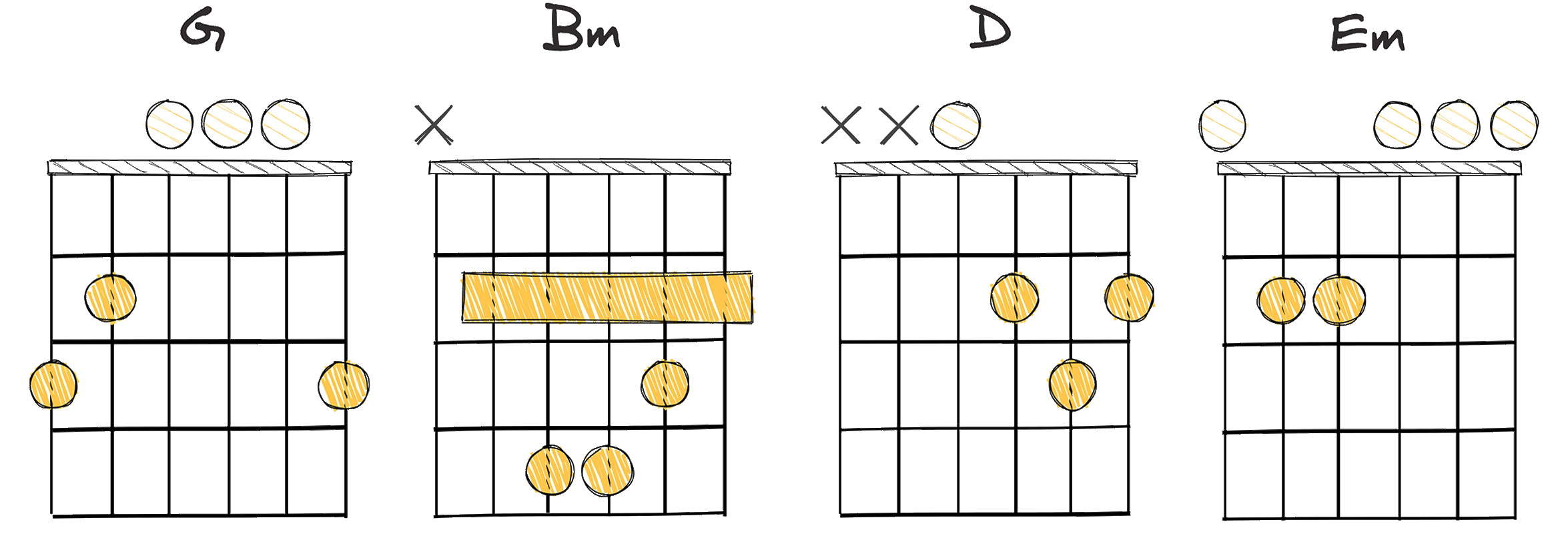
When we delve deeper into the realm of music theory, the IV-vi-I-ii (4-6-1-2) chord progression is one that stands out due to its complexity and beauty.
This chord progression is considered to be an intermediate level progression, as it requires a certain degree of musical knowledge and technical proficiency to play it correctly and with fluidity.
In the music world, chords are the building blocks of composition and understanding chord progressions is essential to creating beautiful, compelling music.
Historically, many of the greatest composers and songwriters have utilized this particular progression to bring a unique feel to their compositions.
Furthermore, this chord progression is flexible and can be adapted and tweaked to fit a variety of musical genres and styles.
Understanding and mastering this progression can offer endless opportunities for musicians to experiment with their creativity.
It creates a tension and release pattern that engages listeners and provokes a strong emotional response.
Essentially, the IV-vi-I-ii chord progression is a powerful tool for composing music that resonates with listeners on an emotional level.
Furthermore, this progression opens up a gateway to deeper musical exploration and experimentation.
However, it’s important to note that mastering this chord progression requires a strong understanding of major and minor chords and their function within a scale.
Given the different tonal qualities of these chords, it’s crucial to practice and familiarize oneself with them to properly execute this progression.
Ultimately, IV-vi-I-ii is a beautiful chord progression that has the potential to bring a new level of sophistication and depth to any musical piece.
IV-I-V-vi (4-1-5-6)
A versatile progression invoking journey, resolution, and delicate melancholy.
The IV-I-V-vi progression is a captivating chord progression common in many genres of music, from pop to classical. It is characterized by its emotional depth, often evoking a poignant, nostalgic feel, and its versatility, as it lends itself remarkably well to many different musical styles and compositions.
- Difficulty: Intermediate
- Example: Bb – F – C – Dm (Key of F major)
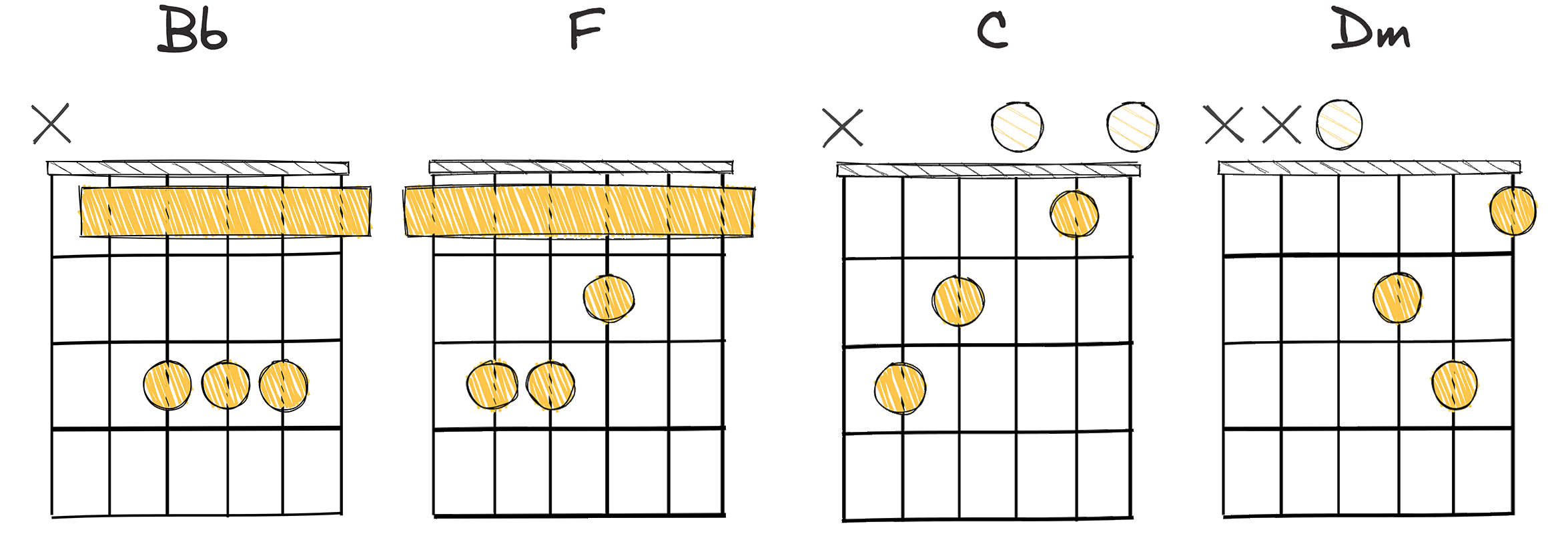
The chord progression in a musician’s song will determine its harmony and overall sound.
Knowledge of chord progressions is paramount for musicians, acting as the foundation upon which melodious tunes are formed.
Among the many beautiful chord progressions available to musicians, the IV – I – V – vi (4 – 1 – 5 – 6) chord progression holds special significance.
Known for its appealing harmonic structure, it features regularly in popular music, captivating listeners through its emotive power.
This progression is characterized by its shift from the dominant tone to the tonic and then involves the subdominant tone and switches to the minor.
The transition from the V (dominant) to vi (submediant) adds a nuance of melodic surprise due to its shift from a major to a minor chord.
In the context of the key of F major, the IV – I – V – vi progression translates to the cords Bb – F – C – Dm (B flat major – F major – C major – D minor).
This set of progressive chords is relatively easy to play, ensuring that novice musicians can also experiment with it.
Furthermore, exploring this chord progression broadens a musician’s compositional capabilities.
It offers a wealth of creative potential for composing harmonious tunes capable of evoking a range of emotions.
Moving from the dominant name to the tonic and then to the subdominant and pre-dominant chords offers a playful dynamic of tension and release – a feature characteristic of IV – I – V – vi progression.
No matter the musician’s skill level, the IV – I – V – vi progression is a valuable tool for creating beautiful, poignant songs.
It’s worth experimenting with this progression, mastering its unique sound to enrich your own musical pieces.
vi-ii-IV-I (6-2-4-1)
A dreamy and emotional chord progression inspiring nostalgic vibes.
The vi-ii-IV-I chord progression, also known as the 6-2-4-1 progression, is a popular and versatile musical arrangement that creates a comforting sense of resolution and closure. It’s often used in pop, rock, and jazz music for its ability to seamlessly transition from a minor, introspective mood to a major, uplifting finish.
- Difficulty: Intermediate
- Example: F#m – Bm – D – A (Key of A major)
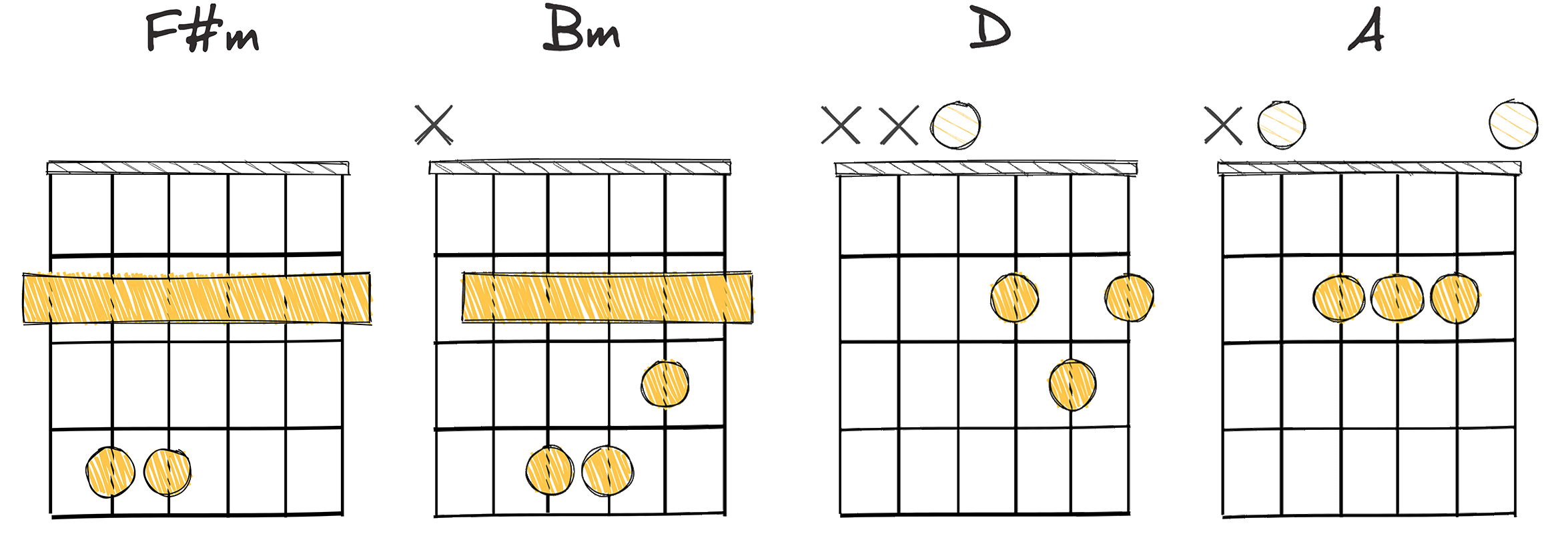
One beautiful chord progression every musician should absolutely know is the vi-ii-IV-I (6-2-4-1) progression.
This chord progression holds a bare bone beauty that’s both simple and complex, at the same time.
Historically speaking, the vi-ii-IV-I progression has been used often in many genres, from pop to jazz to classical music.
Ever since the renaissance period, composers have been employing this progression to create some of the most enduring pieces of music in our canon.
The vi-ii-IV-I progression starts with the vi or the minor sixth chord, which gives us a soft, melancholic beginning.
This is then followed by the ii or minor second, which sustains the initial mood.
The progression then leaps to the IV, the major fourth chord.
This introduces a substantial shift in mood, lifting the melancholy to hopeful.
The final chord in the progression is the I or the major first, which ends the progression on a resolved, uplifting note.
This creates a balance between the light and the dark, making the resulting music profoundly emotional.
The power of this progression lies in its versatility and its ability to invoke a range of emotional responses from the listener.
In the key of A major, the chords would be F#m – Bm – D – A.
You may have noticed these chords in many popular songs, which just goes to show how enduring and beloved this progression is among songwriters and composers.
The beauty of the vi-ii-IV-I progression is that it can be manipulated and repurposed in countless ways to fit a variety of musical styles and moods.
This makes it a great tool for musicians of all types and skill levels.
So, whether you’re a songwriter seeking inspiration for your next melody, or a musician looking to learn some new chords, the vi-ii-IV-I progression is an excellent addition to your musical toolbox.
Remember, understanding and using well-known chord progressions like the vi-ii-IV-I is an essential part of becoming a more accomplished and well-rounded musician.
IV-V-I-vi (4-5-1-6)
A classic, versatile progression providing intrigue and emotional depth.
The IV-V-I-vi chord progression is a universal sequence commonly found in a variety of music genres, known for its melodically pleasing and harmonically satisfying quality. The progression creates tension by moving from the subdominant (IV) to the dominant (V) chords, which is then resolved with a tonal shift to the tonic (I), before finally transitioning to the relative minor (vi) to add an emotional touch.
- Difficulty: Easy
- Example: F – G – C – Am (Key of C major)
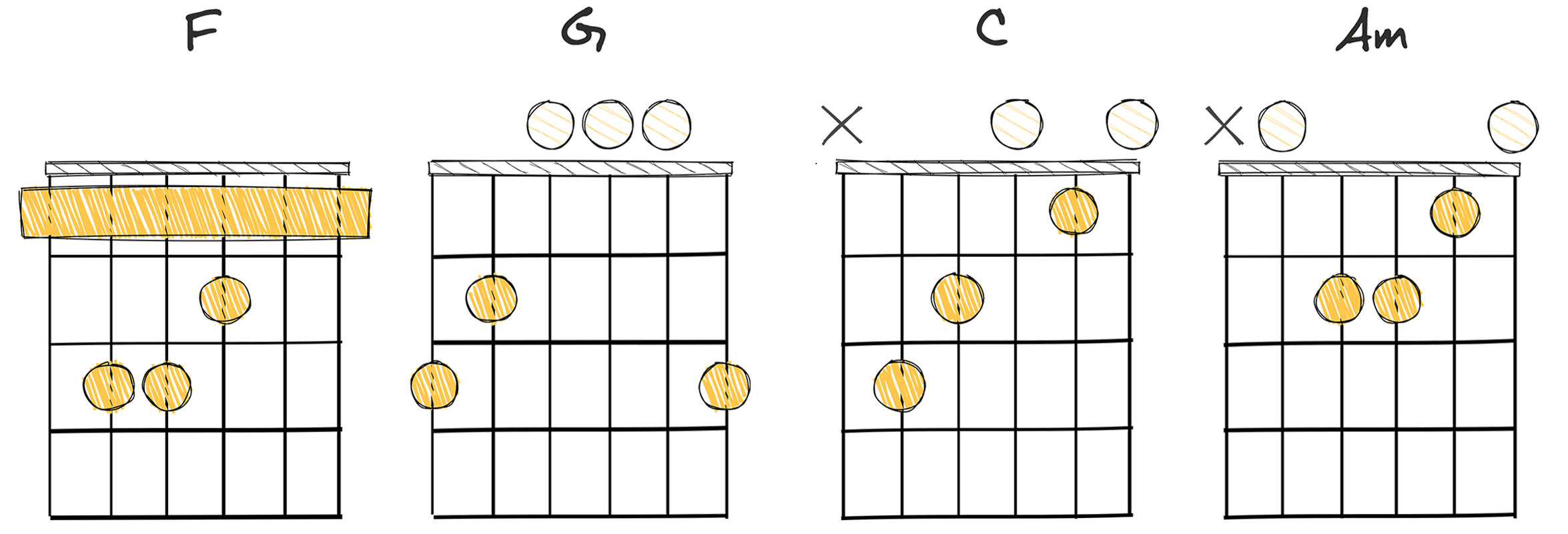
Simplicity often holds the key to beauty, and this is evident in the IV-V-I-vi (4-5-1-6) chord progression, often dubbed as one of the most beautiful chord progressions in music.
This charming chord sequencer’s beauty lies in its ability to create a harmonic movement that is easy on the ears, yet full of depth and richness.
The notable thing about this chord progression is its versatility, lending itself well to various music genres, from pop and rock to jazz and blues.
The IV-V-I-vi chord progression has ingrained itself into the fabric of many memorable tunes throughout history.
As further proof of the beauty and versatility of this progression, many renowned musicians have shimmered their songs with its fairy dust.
Shifting our focus to the technical side, the IV-V-I-vi progression, especially in the key of C major, is quite easy to play on most instruments.
For example, on a piano or keyboard, this progression translates to F – G – C – Am, which are all straightforward chords to play.
The key’s composition of white keys renders it remarkably accessible even for beginners.
Moreover, using this succession of chords delivers a satisfying resolution that gently guides the listener’s ear from chord to chord.
Playing these chords in the presented order creates a musical story that has a clear beginning (IV), a developing plot (V), a climax (I), and an ending that leaves the listener wanting more (vi).
On a broader view, the use of this progression signifies a preservation of musical tradition while allowing scope for innovation and creativity.
Musicians continue to explore new methods to use this progression and combine it with other musical elements to develop their unique sound and style.
In essence, the IV-V-I-vi progression echoes the timeless appeal of simplicity and the boundless creativity in music.
vi-IV-V-I (6-4-5-1)
A timeless progression, driving countless global hits with its magnetic pull.
The vi-IV-V-I progression is a beautiful and classic chord sequence frequently used in both pop and classical music, known for evoking strong emotions. The journey from the minor sixth to the major first chord via the fourth and fifth chords creates a tonal variation that can enhance any piece of music.
- Difficulty: Easy
- Example: Am – F – G – C (Key of C major)
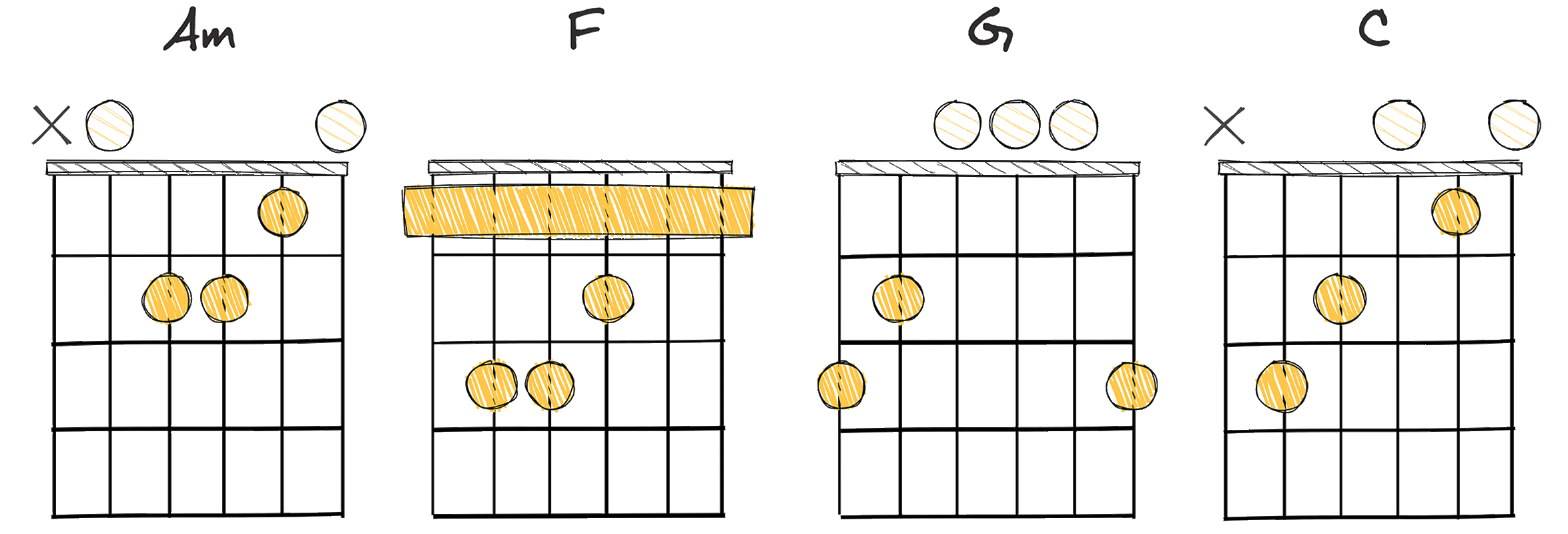
The vi-IV-V-I (6-4-5-1) progression is without a doubt a timeless beauty in the family of chord progression that every musician should familiarize themselves with.
This chord progression, in its essence, is a sequential harmonic pattern that creates a sense of resolution and completion in a piece.
The intricate soundscape produced by the vi-IV-V-I progression can be traced back to the classical period of music, where it was fervently used to introduce and conclude various themes.
Acknowledging the rich history of this mesmerizing chord progression affirms its weight in the evolution of music, subsequently facilitating its understanding.
Ironically, despite being centuries old, the vi-IV-V-I progression has never lost its charm and continues to remain a powerful tool in the hands of modern musicians.
This statement underlines the fact that music, like language, also evolves yet inherits certain elements of its past, and the vi-IV-V-I progression is one of them.
We can witness its usage in numerous contemporary pop, rock, and even electronic music genres, solidifying its relevance in the current music scene.
When it comes to the simple playability of the vi-IV-V-I progression, the chords are very basic and easy to form, making it a common choice for beginners as well.
The Bottom Line
Insights gleaned from this analysis reveal the significant role of chord progressions in creating different moods and tones in music.
The frequently used progressions such as I-IV-V (1-4-5), II-V-I (2-5-1) and I-V-vi-IV (1-5-6-4) are popular because of their versatility and compatibility with many genres.
Meanwhile, more complex progressions like iii-vi-II-V (3-6-2-5) and II-VII-III-V (2-7-3-5) introduce starker, more dramatic shifts in tone and are often reserved for specific musical moments.
With such a vast array of arrangements, these unique sequences create continuous musical diversity and ensure the resonation of emotion with listeners.
Therefore, understanding these progressions is not only central to composition, but also to a more enriching experience of music as a whole.
In love with guitars, and gear; expert in all things music! Been writing about guitars for about 5 years and counting. Born in the ’90s. Alma Mater: University of Havana. Always curious, trying to understand the world. #TeamFender




